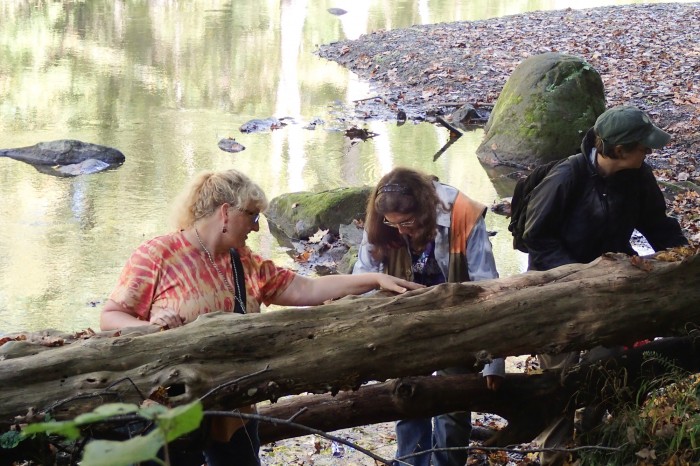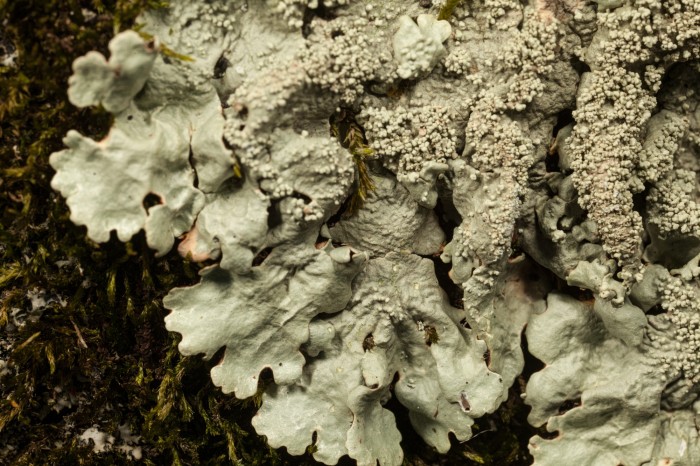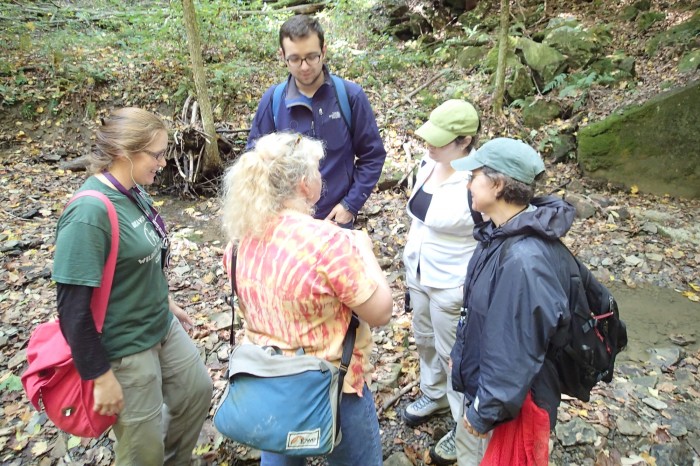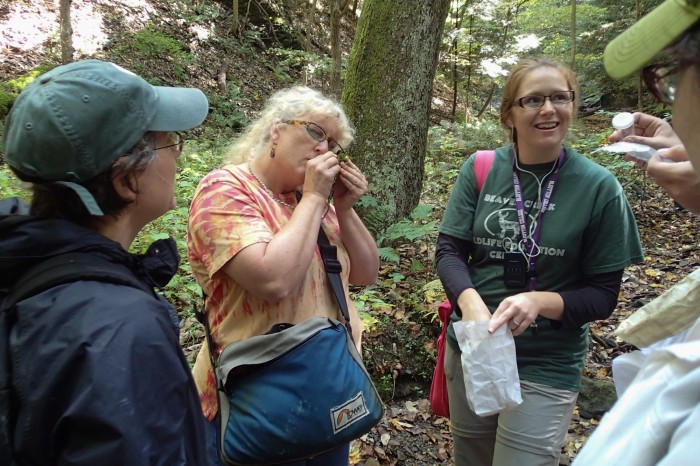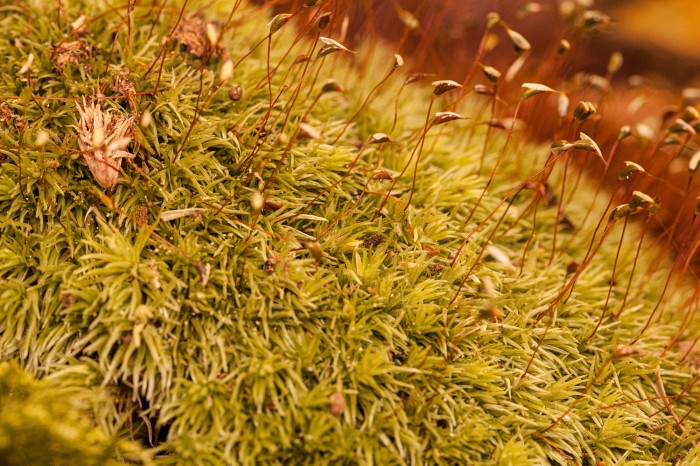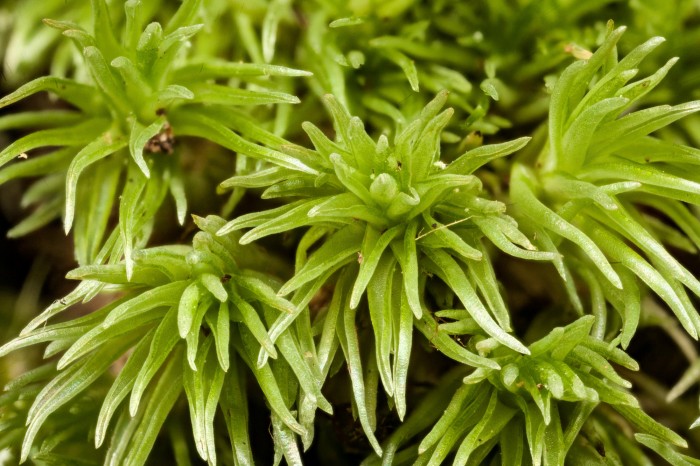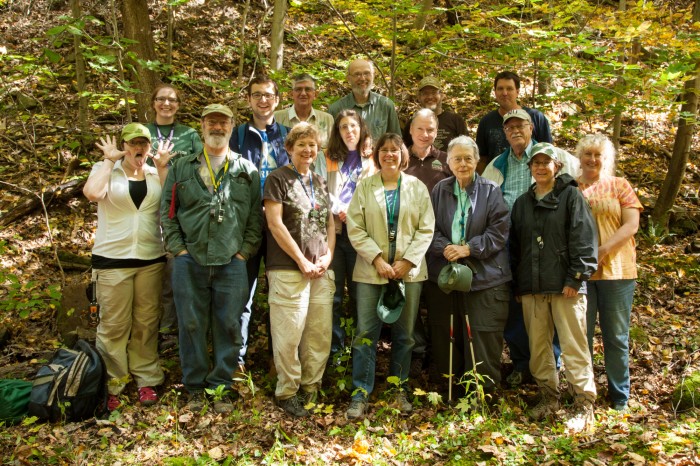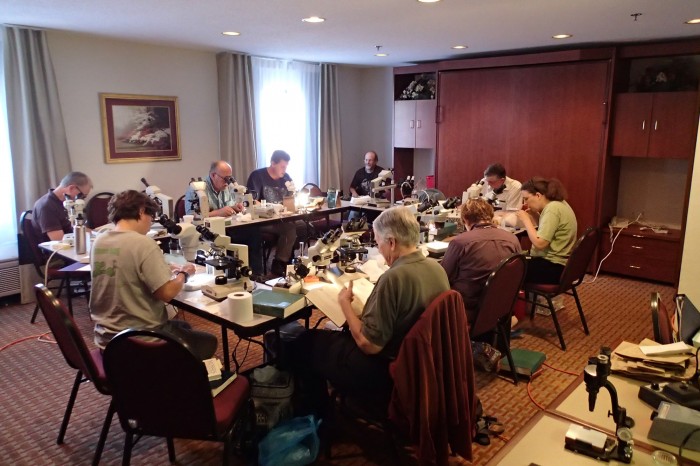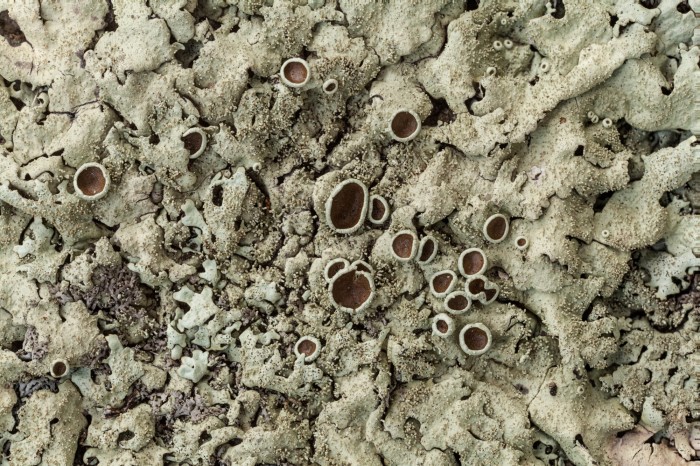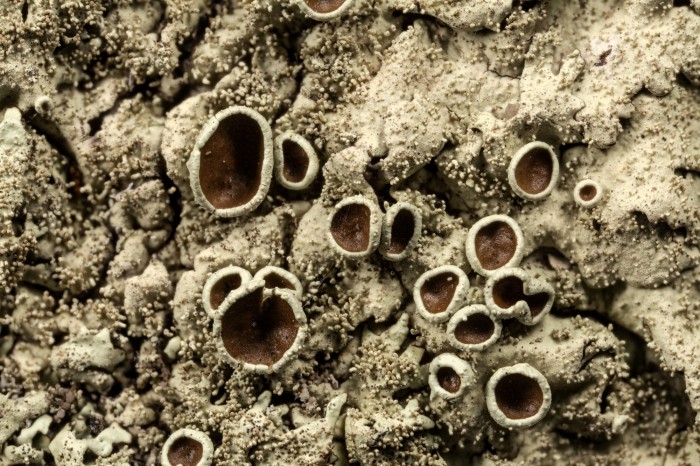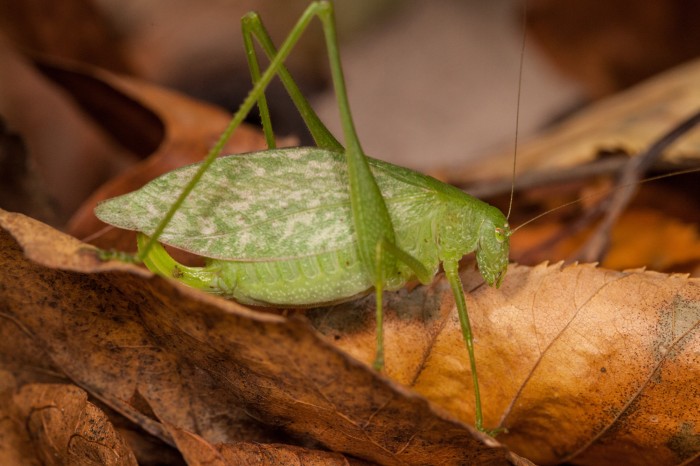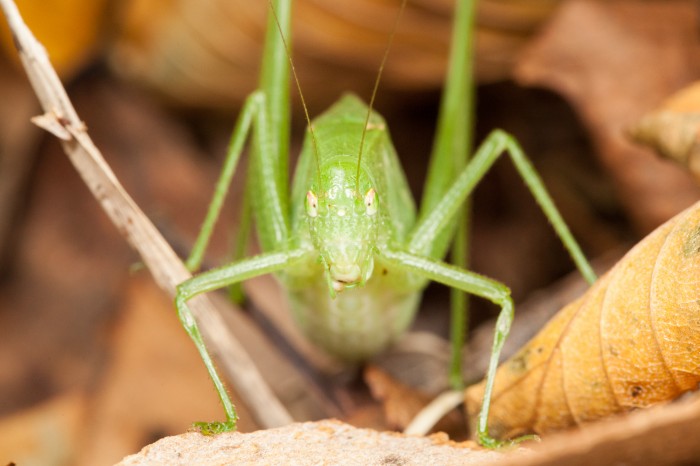What else but a beautiful fall day for a foray to Columbiana County in eastern Ohio? We spent Saturday September 28 at Sheepskin Hollow State Nature Preserve, then Sunday at Beaver Creek State Park, both areas in the unglaciated portion of the county.
The 453-acre Sheepskin Hollow Preserve has deep ravines with sandstone and shale outcrops among extensive forests of eastern hemlock and mixed hardwoods, providing a great diversity of habitats for bryophytes and lichens.
There were plenty of moist habitats for collecting liverworts. We identified 13 species of liverworts from Sheepskin Hollow and another 2 species from Beaver Creek State Park.
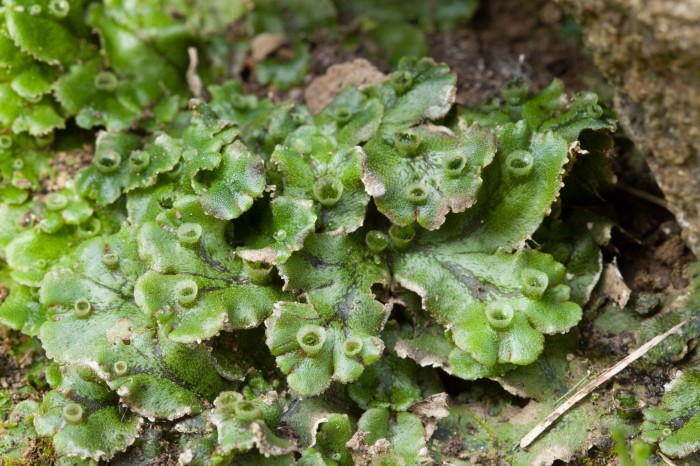
One of the more renowned liverworts, Marchantia polymorpha, with
abundant gemmae in the cups on the upper surface.
With areas of ample sunlight and a variety of substrates, lichen hunting was very productive: we found 37 lichen species, 28 of them new for Columbiana County.
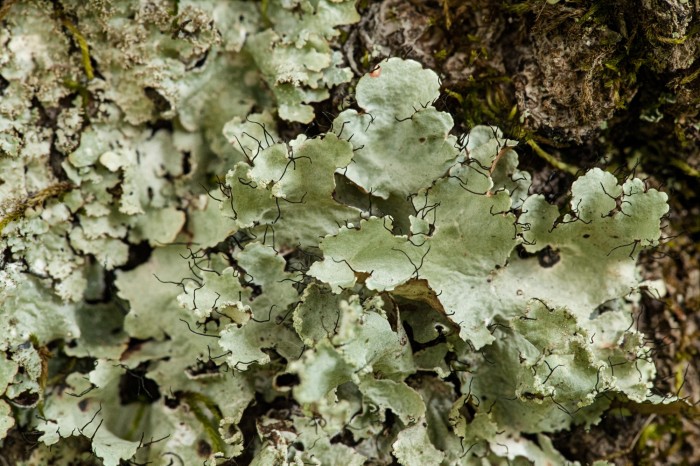
Parmotrema hypotropum, also known as the Powdered Ruffle Lichen.
It occurs almost exclusively on tree bark.
Leucobryum glaucum (pictured below) also goes under the common name of “pincushion moss” because it often forms round, whitish-green tufts several inches in diameter on the forest floor. Our timing was perfect: many of the ripening capsules still have the calyptra (whitish veil on the top and back of the capsule) attached. In most species (including L. glaucum) it soon falls off as the capsule begins to ripen.
After a day in the field on Saturday, we stop for dinner and head to the scope room for the excitement of identifying our specimens. The crowd thins out a bit as the evening rolls on, but the action continues well into the night. Our sincere thanks to the staff of the Comfort Inn of East Liverpool for helping us set up the trip and providing us a great place to stay!
The next day it’s up early and off to Beaver Creek State Park, about 5 miles from Sheepskin Hollow. With a total of 2722 acres, the park has sandstone cliffs as well as bottomlands along Little Beaver Creek. The forested hills are quite a spectacle, especially for those of us who are flatlanders from the glacial lake plains of northwest Ohio.

Getting together at Beaver Creek State Park before we head out
in all directions for another day of collecting!
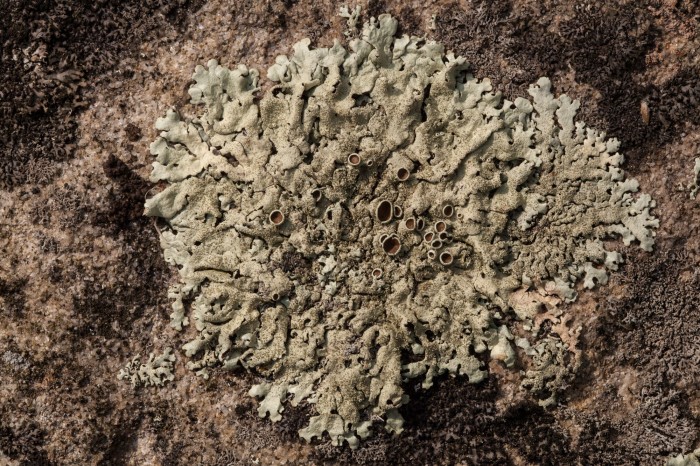
Xanthoparmelia plittii on sandstone. In Ohio this species occurs primarily
in the southeastern counties.
.The park also contains remnants of the historic Sandy and Beaver Canal, which operated until 1853.
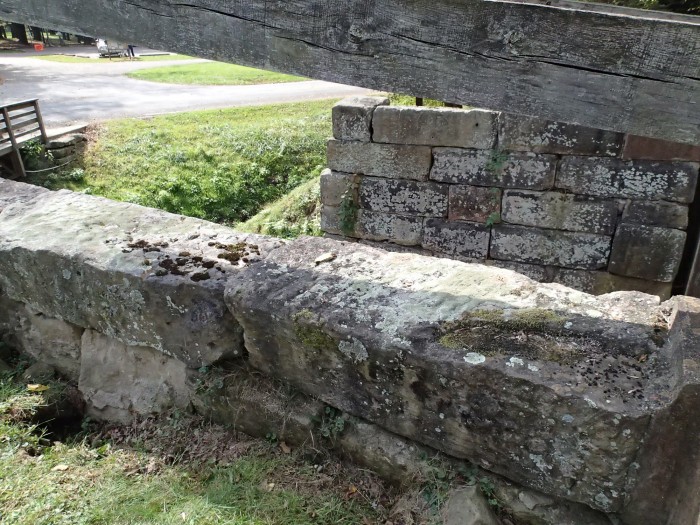
Lusk’s Lock (also known as Simon Girty Lock) on the Sandy and Beaver Canal
graciously provides some pleasant moss and lichen habitat.

Gymnostomum aeruginosum, a moss that occurs mainly on wet calcareous rocks.
It is widely distributed throughout the United States and Canada,
and is a new record for Columbiana County.
Lichens of the 2013 Fall Foray in Columbiana County
* = new county record
Candelaria concolor*
Canoparmelia crozalsiana*
Cladonia coniocraea
C. macilenta
C. rei*
C. sobolescens*
C. squamosa
Dermatocarpon luridum*
Flavoparmelia baltimorensis*
F. caperata*
Flavopunctelia soredica*
Heterodermia speciosa*
Lecanora symmicta*
Leptogium cyanescens*
L. juniperinum*
L. lichenoides*
Melanelia subaurifera*
Myelochroa aurulenta
Parmelia squarrosa
P. sulcata
Parmelinopsis minarum*
Parmotrema hypotropum*
Peltigera evansiana*
Phaeophyscia adiastola*
P. cernohorskyi*
P. decolor*
P. rubropulchra*
Physcia adscendens*
P. aipolia*
P. millegrana
Physciella chloantha*
Physconia detersa*
Porpidia albocaerulescens*
Punctelia rudecta
P. subrudecta
Pyxine sorediata*
Usnea mutabilis*
Xanthomendoza ulophyllodes*
Xanthoparmelia plittii*
X. tasmanica*
Bryophytes of the 2013 Fall Foray in Columbiana County
* = new county record
S = Sheepskin Hollow State Nature Preserve
B = Beaver Creek State Park
♦ Collected by Jim Bissell at Beaver Creek State Park on 9/13/2013
⊕ Collected by Diane Lucas with Barb Andreas about 10 years ago, wet ditch just east of US Rte. 7 near Rte. 45 exit.
Mosses
Amblystegium serpens (S)
A. varium (S)
Anomodon attenuatus (S)
A. minor* (S)
A. rostratus (S)
Atrichum altecristatum* (S)
A. crispulum* (S)
Aulacomnium palustre (S, ⊕)
Brachythecium campestre* (S)
B. curtum* (S)
B. laetum (S, B)
B. plumosum* (S)
B. rivulare (S)
B. rutabulum (S)
Bryhnia graminicolor* (S)
B. novae-angliae (S)
Bryum flaccidum* (B)
B. lisae var. cuspidatum (B)
Callicladium haldanianum (S)
Campylium chrysophyllum (S)
Clasmatodon parvulus* (S)
Climacium americanum (B)
Cyrto-hypnum pygmaeum* (S)
Dicranella varia (S, ⊕)
Dicranum montanum (S)
D. flagellare (S)
D. fulvum (S, ♦)
D. montanum (S)
D. scoparium (S)
Entodon seductrix (S, B)
Eurhynchium hians (S)
Fissidens minutulus* (S)
F. obtusifolius* (S, B)
F. taxifolius (B)
Gymnostomum aeruginosum* (B)
Hedwigia ciliata* (S)
Herzogiella striatella* (S)
H. turfacea* (B)
Hymenostylium recurvirostrum* (S)
Hypnum curvifolium (S)
H. imponens (S)
Isopterygiopsis muelleriana (S)
I. pulchella* (S)
Isopterygium tenerum* (S)
Leptodictyum humile* (S)
Leskea gracilescens* (S)
Leucobryum glaucum (S)
Orthotrichum ohioense* (B)
O. pumilum (B)
Physcomitrella patens* (B)
Plagiomnium ciliare (S)
P. cuspidatum (S)
P. ellipticum* (S)
Plagiothecium cavifolium (S)
P. laetum (S)
Platygyrium repens (S)
Platyhypnidium riparioides* (S)
Pohlia wahlenbergii (⊕)
Polytrichastrum ohioense (S)
Polytrichum commune (⊕)
Pseudotaxiphyllum elegans (S)
Pylaisiadelpha tenuirostris* (S)
Rhynchostegium serrulatum (S)
Schistidium apocarpum* (B)
Sematophyllum adnatum* (S)
S. demissum (S)
Sphagnum fimbriatum (⊕)
Taxiphyllum deplanatum (S)
Tetraphis pellucida (S)
Thamnobryum alleghaniense* (S)
Thuidium delicatulum (S, ♦)
Tortula truncata* (B)
Weissia controversa (S)
Liverworts
Blepharostoma trichophyllum* (S)
Cololejeunea biddlecomiae* (S)
Conocephalum conicum* (S)
C. salebrosum* (S)
Frullania eboracensis* (S)
Jungermannia crenuliformis* (⊕)
Lophocolea heterophylla* (S)
Lophozia capitata* (⊕)
Marchantia polymorpha* (B)
Metzgeria conjugata* (S)
M. furcata* (S)
Nowellia curvifolia* (S)
Pellia epiphylla* (S)
Plagiochila porelloides* (S)
Porella platyphylla* (S)
Ptilidium pulcherrimum* (B)
Scapania nemorea* (S)

